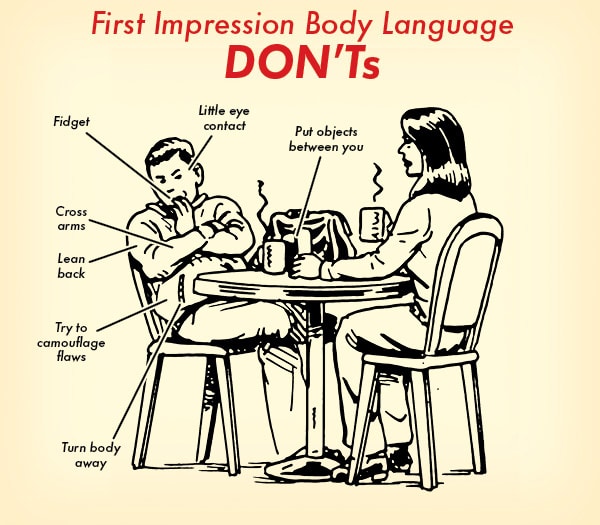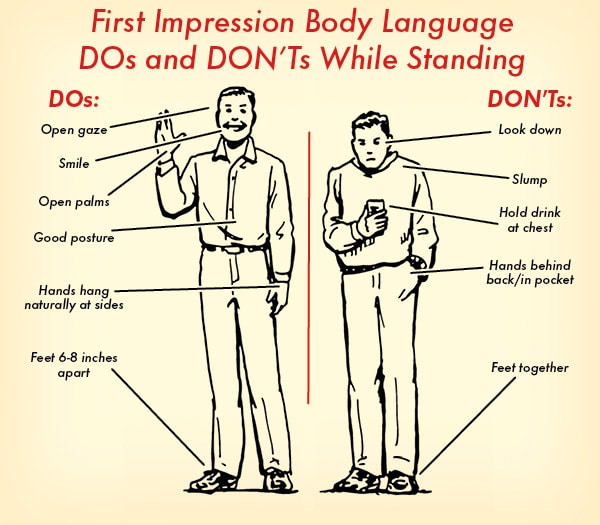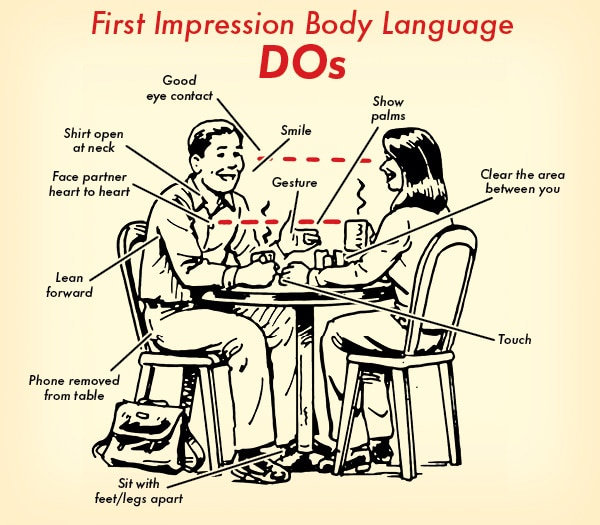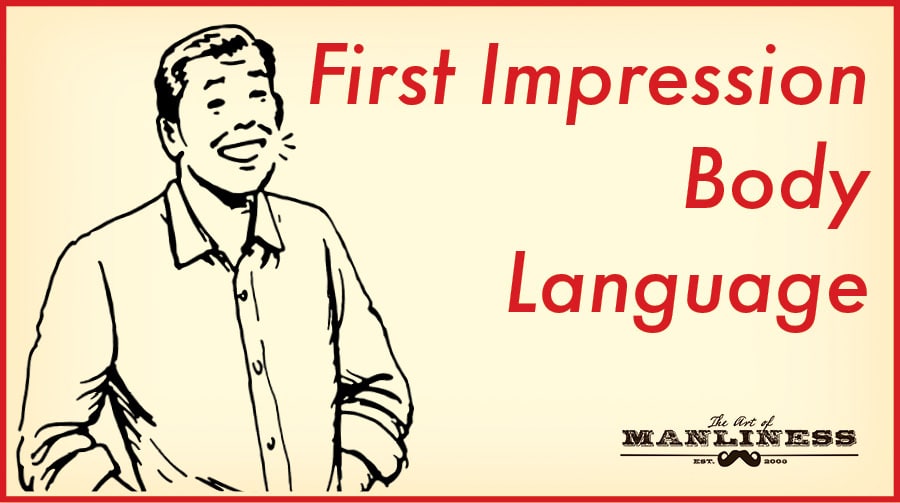
Last week we talked about why your first impression matters — how amazingly quickly other people form one of you, and how difficult it is to overcome that initial assessment.
We also explained how first impressions aren’t about trying to be someone you’re not, but getting your conversational strategies and body language to match and enhance your true feelings, values, and personality. Sometimes we act in ways that contradict how we really feel, and create barriers to people accessing our best qualities. Improving your first impression clears these obstacles, increasing the chances that new acquaintances will be able to connect with you and better get to know who you really are. Nailing the “mechanics†of a good first impression gives you the assurance that its outcome — good or bad — will be based on actual compatibility, rather than a misfiring of external cues.
There are two components to creating a positive first impression: what you say (conversation) and how you act (body language). Both components are important (you can read more about the art of conversation here), but the latter is actually much more influential.
Nonverbal cues have 4X the impact on your impression than your words do. Thus, how you stand, sit, gesture, and generally hold yourself can either significantly enhance or detract from the overall first impression you make on others.
In order to make your body language a first impression booster, you want it to communicate 3 main things: openness, confidence, and interest.
Body Language That Communicates Openness
Have you ever needed to ask someone to take a picture for you, or looked around the room at a party trying to decide who to talk to? How did you pick? You may not have realized it, but you likely chose someone who looked “open†rather than “closed.†There was something about their facial expression, gaze, posture, and the way they talked and interacted with others that seemed warm, safe, and approachable rather than threatening, hostile, aloof, and/or self-contained.
How do you achieve such a welcoming aura yourself, so that people want to make contact in the first place, and can feel a sense of connection with you once they do?
It’s primarily about opening up what body language expert Patti Wood calls your “body windows.â€
Body windows are parts of the body that influence others to see you as more open or closed, all depending on how you orient them. These are places that feel intimate and/or are vulnerable to physical attack. When you “expose†them to others, therefore, the more primal part of people’s brains reads you as more accessible and approachable.
Wood compares someone who keeps these body parts “closed†to a house with boarded up windows — the effect is bleak, creepy, confined, and off-putting; you certainly don’t want to go in. A house with open windows, in contrast, feels fresh, welcoming, and inviting.
Let’s take a look at each “window†and how you can either close or open it:
Heart. The heart is the metaphorical seat of feelings like love and warmth, as well as values like honesty. It’s not surprising then that having a frank, emotionally intense conversation is known as having a “heart to heart.â€
People will feel more connected to you, and open up more, if you face them straight on — literally heart to heart. You come off as more trustworthy when you’re dealing with them “straight.†Even a quarter turn away from someone can make the interaction feel less intimate.
Eyes. Eyes are famously said to be the windows to the soul. So don’t always have their shades drawn by staring at your feet, or at your phone. Don’t wear sunglasses unless you really need them. And try not to blink excessively.
Look around with an open gaze, and don’t be afraid to make warm, friendly eye contact with other people. Eye contact very often serves as an invitation for someone to approach.
Throat. Baring the throat makes one vulnerable to attack. When you’re wearing a button-up shirt and tie, which doubly covers your neck, you convey a closed-off, protected authority, which can be helpful in the competitive world of business. But in a social setting, an open neck reads as warm and welcoming.
So in your off hours, remove your tie, and unbutton your shirt a little. Or wear a v-neck tee, which not only reveals your neck, but offers a little more access to your heart as well. Not too deep mind you; a few inches from your collarbone will do.
This is perhaps why turtlenecks don’t make a great impression. Well, also, because, turtlenecks.
Mouth. A frown registers instantly in the primal parts of the brain as a potential threat. A smile signifies an invitation. It bespeaks friendliness, warmth, and openness. And when you smile at someone, they feel as though you find them appealing.
Stomach. One of the most common things to do with your arms is to cross them across your stomach. But this stance reads as defensive and puts a barrier between you and others that makes you seem more distant and aloof. Research actually bears this perception out; when a group of participants were asked to listen to a lecture while keeping their arms crossed, they felt more negatively towards the speaker and reported higher levels of stress than the control group. So to not only feel less stressed yourself, but to also convey more openness to others, sit and stand with arms by your sides rather than crossed over your stomach, even if it feels a little awkward.
Hands. Specifically your palms. For whatever reason, it’s hard to lie while showing your palms. Dishonest people will ball them into fists, hide them in pockets, tuck them under the table, or secrete them behind their back. Conversely, showing open palms to others conveys honesty, trustworthiness, and openness. So leave your hands at your sides and to the front, and make plenty of gestures with an open palm.
Feet. Wood calls the feet “the most honest windows†of the body. Though we can often consciously control other parts of our body, especially our upper half, she explains, our true feelings tend to “‘leak out’ through the feet.†One of these “tells†is what she calls the “foot lock,†where “one foot wraps around the leg, usually at the lower calf.†This bit of body language, Wood says, “is like having a ‘closed’ sign hanging on the door.â€
In addition to opening up each of your “body windows,†you should also be mindful of clearing away any objects between you and another person. So don’t hold a beverage up to your chest while you’re standing at a party, and when you’re sitting face-to-face with someone at a restaurant or coffee shop, don’t put your drink, laptop, backpack, phone, etc. on the table between you. In fact, don’t put your phone on the table at all. Research shows that its mere presence — even if you’re not looking at it — leads people to keep their conversation more superficial; they subconsciously feel they may be interrupted at any time, and so refrain from going deeper.
All in all, you want your body windows open, and the channel for connection clear.
Body Language That Communicates Confidence
Just because you should seek to display openness and a little vulnerability, doesn’t mean you want to come across as timid or docile. On the contrary, being able to demonstrate some vulnerability shows that you feel strong and secure — that you’re not worried about being “attacked†or hurt.
Confidence in general in fact contributes to a more positive first impression for several reasons.
First, when you’re anxious and nervous, this can create a visceral reaction of suspicion in people. They can’t be sure if you’re anxious simply because you’re shy, or because you’re hiding something.
Second, insecurity reads as a potential social cost. As we discussed last time, people like people who are a social benefit, rather than a social burden. Someone who’s insecure is going to be really needy, and need a lot of affirmation. People can instinctively see the kind of energy they’re going to need to divert into constantly buoying the person up, and this makes them want to back away.
Third, confidence is an in-demand resource, not only in ourselves, but in those we associate with. People like to partner up with others who raise their own status. And they like comrades who will help them navigate life with aplomb; everyone wants someone with moxie on their team.
Finally, your comfort level affects that of other people. When you feel anxious and insecure, your demeanor spreads, and the people around you start feeling that way too. Conversely, when you feel relaxed and comfortable with yourself, that helps put other people at ease. The aura of confidence creates a pocket of safety and security, and people want to be in it.
Here’s how to create that aura with your body language.
Don’t try to mask or camouflage something you’re insecure about. If there’s something about yourself that makes you feel ashamed or embarrassed, you may try to cover it up. For example, maybe you’ve got bad teeth, so you never open your mouth when you smile. Or you’re not proud of your flabby body, so you wear a t-shirt when you go swimming.
The thing is, that in trying to mask a physical shortcoming, you not only end up drawing more attention to it, but you also reveal your insecurity. And that’s more unattractive than whatever it is you perceive to be a hideous flaw. People will feel you are self-absorbed, and will thus have insufficient energy to invest in them.
Plus, your efforts to camouflage your flaw may end up reading in a negative direction you didn’t anticipate. So in the example of having bad teeth, others may wonder why you never really smile, and decide that it’s because you’re rather strange and aloof.
Being attractive certainly helps in making a good first impression. But confidence can truly compensate for a lot of physical shortcomings. People are drawn to those who embrace themselves, have fun with their flaws, and really don’t seem to give a damn. As Wood advises, “You make yourself more attractive when you show comfort in your own skin, and show pride rather than shame.â€
The more you expect to be found appealing, the more you will be.
Practice poise. You may think of poise as something practiced by debutantes, but it’s a quality that benefits both sexes. When you’re constantly fidgeting — tapping your foot, biting your nails, touching your moustache, cracking your knuckles, etc., you come off as anxious. When you repose with a regal stillness, you become an oasis of calm, stately confidence.
Stand with good, balanced posture. Good posture signifies health and confidence. You don’t want your posture to be too rigid though; you should be standing up straight, but your body should feel relaxed.
Distribute your weight equally on each foot, for, as Wood explains, “Balance centers you and actually makes you appear visually more balanced and attractive to others.â€
To project maximum strength and confidence, men should stand with their feet about 6-8 inches apart — taking up space denotes power. Don’t let them drift too far apart though; men will widen their stance to 12 inches or more when facing a threat or confrontation, a posture that reads as too defensive and aggressive for a social setting.
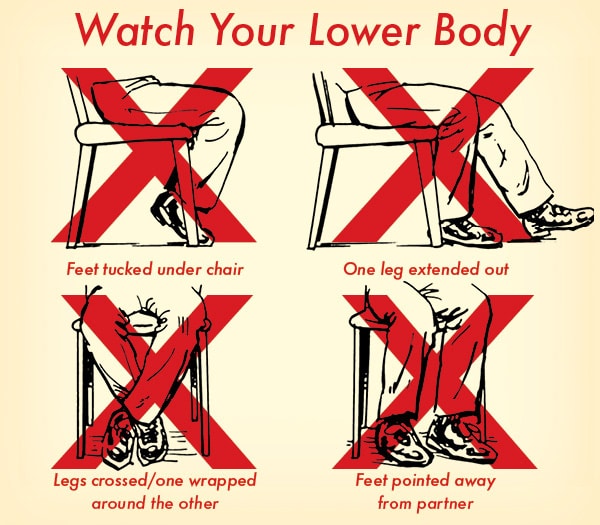
Initiate contact and move towards others. Not only are your feet a revealing barometer of your true feelings, but your whole lower half is as well. As Wood explains, this is because “It is under the least conscious control and tends to be the first part of the body to respond to stress with the freeze-flight-fight-or-faint response. It is not surprising that, when we meet someone for the first time, or start an interaction, we feel a bit stressed. We may freeze up or step or lean back in retreat.â€
To show confidence then, be the one who initiates contact with others. It’s nice to be approached, naturally, but people find it flattering when you move towards them. Step towards others while projecting a warm disposition and with a smile on your face, so that your approach seems friendly, rather than threatening. And once you start to interact, rather than retreating, hold your ground, while still respecting people’s personal space, of course.
Watch your feet. Even if the fight-or-flight response doesn’t have your feet actually stepping backwards, you may find them subconsciously pointing away from the person you’re interacting with, and towards an exit — contradicting the impression that you’re confident and present.
Nerves may also cause you to move your feet together when you’re sitting or to tuck them under your chair. But just like when standing, a nice amount of space between your dogs denotes relaxation and confidence, and they come off as more confident when planted firmly in front of you.
Gesture when you talk. As Ricky Bobby can attest, it’s hard to know what to do with your hands. You want to keep them open, as we mentioned, but it can feel awkward to just let them dangle at your sides. So naturally gesture with your hands as you talk. Not only have expressive people been found to make others feel more comfortable, but making gestures has also been shown to cut down on your tendency to say “uhhh†and “ummm.â€
Body Language That Communicates Interest
There’s probably not a truer truism of making a good first impression than the fact that people like people who are interested in them. Why is this the case? Because interest invariably becomes reciprocal. As Wood explains:
“If you show people that you are interested in them, like them, and respect them, they are simply more likely to feel the same way about you than if they don’t know your feelings of interest or attraction. Thus, if you show interest in someone, you are more likely to be the object of his or her interest.â€
Interest cannot only be conveyed by asking someone plenty of open-ended questions and listening attentively while they talk, but also by the kind of body language you exhibit. In some instances your behaviors will be a continuation of what you started in order to convey openness, but now have an added layer of meaning in the context of interacting.
Continue smiling. Frequent smiles show that you’re enjoying the conversation and the person’s company.
Nod. Men tend to be stingy with their nods, worrying that the gesture indicates they’re agreeing with what’s being said. Yet nodding doesn’t have to mean “Yes, I agree†but simply “Yes, I’m listening.â€
Lean in. Leaning shows that you are listening attentively, and that you want to be literally and metaphorically closer to the person you’re talking to. You needn’t spend an entire dinner at the edge of your seat, however; lean back when the conversation moves through lighter lulls, and forward when the discussion dips into heavier and more personal topics.
Make ample eye contact. “Think of eye-to-eye contact as a battery charger,†Wood says. “Unless you plug into the other person, there is no charge between you.†Simply making lots of eye contact isn’t effective, however, and can actually backfire if you do it wrong. People don’t want to be stared at constantly; that creates discomfort. Rather, aim to make eye contact about 60% of the time during a conversation, looking away or down at their mouth about every 5 seconds or so. Here’s much more on how to do eye contact the right way.
Face your partner straight on (especially if they’re a lady). Remember the importance of talking “heart to heart� Continue to orient yourself so that you’re directly facing the person you’re talking with. This strengthens your connection, and facilitates greater eye contact. This is especially important when you’re talking to a woman; if you’re talking to a man, they may prefer to converse side-by-side. Eye contact between men is less important, and the side-by-side stance can feel less confrontational.
Don’t extend your leg. One of the behaviors that most registers as disinterest is sticking your leg out straight in front of you when you’re seated. Perhaps because it seems to set up a barrier, or push the other person away.
Touch. In a study in which half the patrons returning a book to the library were touched by the librarian for a mere half-second, and half were not, those touched reported liking the librarian, and the library, better than the control group. The touched group also reported being in a better mood overall.
Touch creates an instant connection, and good feelings of warmth and intimacy. It tells the touched person they’re attractive and appealing — physically, emotionally, and/or spiritually. And it brings a certain chemistry to encounters.
This is obviously beneficial in potentially romantic interactions. Without that spark, a date can feel like a tepid meeting between platonic acquaintances. First touches — brushed fingers, the hand offered for help out the car, knees touched together in the theater — builds excitement and bespeaks the potential for more intimacy and a deeper relationship.
But touch can be employed beneficially in non-romantic settings as well — even between those of the same sex, and even in the workplace. Obviously in a time of heightened sensitivity to sexual harassment, one has to tread carefully and adapt their touches to the professional context. These touches aren’t sexual, per se, they’re simply reminders that we’re physical beings — flesh and blood humans and not just corporate drones. Light, friendly, affirmative touches like a handshake, a pat on the back, a hand on the shoulder, or even just a tap to get someone’s attention or direct it somewhere else, can build a warmer bond between colleagues.
Keep watching those feet…Feet that migrate towards the door not only show nervousness, but can also indicate a lack of interest. Keep them pointing towards your partner.
…and your crossed arms too. Remember that study where participants who listened to a lecture with their arms crossed felt more negative and stressed? Well they also retained almost 40% less of the information presented. Putting yourself in that kind of defensive posture causes you to lose interest in what someone’s saying.
By employing these body language techniques you can comport yourself in a manner that best highlights your personality and character, and makes the real you more accessible and attractive to others. Practicing good body language helps you get out of your own way when making a first impression, so that you can better connect with the new people you meet each and every day.
Check out our podcast on making your first impression count:


